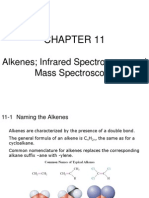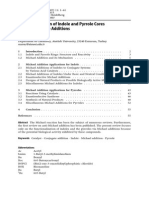Grignard Reactions
Grignard Reactions
Uploaded by
Chris_Barber09Copyright:
Available Formats
Grignard Reactions
Grignard Reactions
Uploaded by
Chris_Barber09Original Description:
Copyright
Available Formats
Share this document
Did you find this document useful?
Is this content inappropriate?
Copyright:
Available Formats
Grignard Reactions
Grignard Reactions
Uploaded by
Chris_Barber09Copyright:
Available Formats
organic chemistry: R- and Hoverview of reactions for R- and Has
as bases
nucleophiles
(faster)
attack carbonyls or epoxides
RMgBr
attack carbonyls or epoxides
RLi
attack carbonyls or epoxides
LiAlH4
attack carbonyls
NaBH4
NaH
Another name for expoxides is oxacyclopropanes.
deprotonate
OH, NH,
or SH
acid-base reactions for R- and Hreactions:
NaH + ROH
HH + NaOR
RMgX + ROH
RH + ROMgX
Similar deprotonation reactions with other O-H, N-H, or S-H groups.
mechanisms:
synthetic utility:
NaH deprotonates alcohols, turning a poor nucleophile/base (neutral O, only good
enough for SN1/E1) into a good nucleophile/base (O-, good enough for SN2/E2).
To replace a functional group with a H:
RMgX + H3O+
RH + H2O + +MgX
+
Or, to replace a functional group with a D: RMgX + D3O
RD + D2O + +MgX
some other useful reactions
to convert a 1 or 2 alcohol to an alkyl bromide:
ROH + PBr3
RBr
to convert a 1 or 2 alcohol to an alkyl chloride:
ROH + SOCl2
RCl
to convert a 3 alcohol to an alkyl halide:
ROH + HX
RX + H2O
(SN1)
(X=Cl, Br, or I)
to synthesize a Grignard reagent: RX + Mg
RMgX,
X = Cl, Br, or I
to synthesize an alkyl lithium:
RX + 2 Li
RLi + LiX
to synthesize an organocuprate: 2 RLi + CuI
R2CuLi + LiI
Organocuprates can act as nucleophiles in an SN2 reaction: R2CuLi + RX
R-R
Grignards and alkyl lithiums, in contrast, cannot act as SN2 nucleophiles.
Synthetic utility: Defunctionalizes, adds carbon-carbon sigma bonds.
Some courses may not cover organocuprates.
www.freelance-teacher.com
organic chemistry: R- and Husing R- to attack carbonyls and epoxides
reactions:
synthetic utility:
Form carbon-carbon bonds.
RMgX + carbonyl forms a new C-C bond, with an O- on the C that was attacked.
RMgX + epoxide forms a new C-C bond, with an O- on the C next to the C that was
attacked.
www.freelance-teacher.com
You might also like
- Chapter12 WorkedExamplesDocument17 pagesChapter12 WorkedExamplesHalil EmreNo ratings yet
- 09 Olefin Add 21Document14 pages09 Olefin Add 21Mario Jimenez LiraNo ratings yet
- Named Reactions in Organic ChemistryDocument5 pagesNamed Reactions in Organic Chemistryapi-237984851No ratings yet
- Schiff and Mannich ReactionsDocument16 pagesSchiff and Mannich ReactionsSat MontesNo ratings yet
- Lecture Notes 2 Nano MaterialsDocument21 pagesLecture Notes 2 Nano MaterialsHuzaifa ShabbirNo ratings yet
- Neighbouring Group Participation or NGP inDocument4 pagesNeighbouring Group Participation or NGP inbharatbhushansankhya100% (1)
- Heart Notes PDFDocument2 pagesHeart Notes PDFChris_Barber09100% (1)
- Extra Chirality ProblemsDocument21 pagesExtra Chirality ProblemsChris_Barber09No ratings yet
- Physics Rules 5Document10 pagesPhysics Rules 5Chris_Barber09100% (8)
- Regents Physics Exam Prep: 101 Facts You Should Know: MechanicsDocument3 pagesRegents Physics Exam Prep: 101 Facts You Should Know: MechanicsChris_Barber09No ratings yet
- Peripheral Nervous SystemDocument1 pagePeripheral Nervous SystemChris_Barber09No ratings yet
- Organic Synthesis. Functional Group InterconversionDocument57 pagesOrganic Synthesis. Functional Group InterconversionJennifer Carolina Rosales NoriegaNo ratings yet
- Organic Chem FlowchartDocument1 pageOrganic Chem Flowchartcadence98No ratings yet
- SN1, SN2, E1 and E2 Reactions in OCDocument60 pagesSN1, SN2, E1 and E2 Reactions in OCHimanshu SharmaNo ratings yet
- Carbon-Carbon Bond Formation: Comprehensive Organic Synthesis 1991, Vol. 2, 99Document31 pagesCarbon-Carbon Bond Formation: Comprehensive Organic Synthesis 1991, Vol. 2, 99mmiliyasNo ratings yet
- Elimination Reactions of Alkyl HalidesDocument24 pagesElimination Reactions of Alkyl HalidesmaulidyaNo ratings yet
- Organic ALL RXN Table 2Document11 pagesOrganic ALL RXN Table 2Angie MTNo ratings yet
- IB Organic Reactions SummaryDocument2 pagesIB Organic Reactions SummaryUrim ParkNo ratings yet
- Stereochemistry: 4 Edition Paula Yurkanis BruiceDocument43 pagesStereochemistry: 4 Edition Paula Yurkanis Bruicenrguerrerod100% (1)
- ChelotropicDocument11 pagesChelotropicChemistry MESNo ratings yet
- Vollhardt 6e Lecture PowerPoints - Chapter 11Document58 pagesVollhardt 6e Lecture PowerPoints - Chapter 11superfr3shmNo ratings yet
- Hetero-Cyclic CompoundsDocument69 pagesHetero-Cyclic CompoundsNaveed SajidNo ratings yet
- Organic Chemistry ReactionsDocument9 pagesOrganic Chemistry ReactionsofferwindumaliyamogamNo ratings yet
- SCH 206-Carboxylic Acids PDFDocument48 pagesSCH 206-Carboxylic Acids PDFShivani DamorNo ratings yet
- C C, C N, C O CouplingDocument67 pagesC C, C N, C O CouplingAnonymous vRpzQ2BLNo ratings yet
- SN1 Vs SN2 ReactionsDocument23 pagesSN1 Vs SN2 Reactionssamnas100No ratings yet
- Organic ChemistryDocument13 pagesOrganic ChemistryGlomela RamirezNo ratings yet
- Org Chem Sem 3 Paper 2Document15 pagesOrg Chem Sem 3 Paper 2Rohit DeshmukhNo ratings yet
- Aromaticity With Huckle's RuleDocument7 pagesAromaticity With Huckle's RuleSk ZNo ratings yet
- RearrangementsDocument22 pagesRearrangementsVipul Newaskar100% (1)
- Synthesis and Characterization of Some 4-Substituted Thiazolidinone DerivativesDocument5 pagesSynthesis and Characterization of Some 4-Substituted Thiazolidinone DerivativesDrBipin DevaniNo ratings yet
- FHSC1124 Tutorial Ebook QDocument72 pagesFHSC1124 Tutorial Ebook QTeo CinnyNo ratings yet
- Reaction of Alkenes and Alkynes For StudentsDocument53 pagesReaction of Alkenes and Alkynes For StudentsGlen MangaliNo ratings yet
- 19 Enolates EnaminesDocument59 pages19 Enolates EnaminesTwas Anassin100% (2)
- Functionalization of Indole and Pyrrole Cores Via Michael - Type AdditionsDocument61 pagesFunctionalization of Indole and Pyrrole Cores Via Michael - Type AdditionsSilvina CancianNo ratings yet
- Aldol Notes PDFDocument8 pagesAldol Notes PDFAna100% (1)
- Pericyclics-2014 Handout PDFDocument79 pagesPericyclics-2014 Handout PDFnavchemNo ratings yet
- HW1 Solns KineticsDocument10 pagesHW1 Solns Kineticsapb91781No ratings yet
- 15 - Aldehyde and KetonesDocument66 pages15 - Aldehyde and KetonesIrfan Raza100% (1)
- SCH 206 Week 1 Lecture NotesDocument52 pagesSCH 206 Week 1 Lecture NotesDemis ZelelewNo ratings yet
- 1 Roh Carboxylic Acids: H CroDocument15 pages1 Roh Carboxylic Acids: H CroandrewwrobleNo ratings yet
- Organic Reaction MechanismsDocument14 pagesOrganic Reaction MechanismstylerNo ratings yet
- Chapter 18 - Carbonyl CompoundsDocument9 pagesChapter 18 - Carbonyl CompoundsNabindra RuwaliNo ratings yet
- Comparing The SN1 and SN2 Reactions - Master Organic ChemistryDocument5 pagesComparing The SN1 and SN2 Reactions - Master Organic Chemistryprince ranaNo ratings yet
- Sn1 MechanismDocument24 pagesSn1 MechanismDian MustikasariNo ratings yet
- Chemistry Project: Saturated Solutions: Measuring SolubilityDocument8 pagesChemistry Project: Saturated Solutions: Measuring SolubilityAbhay Kumar NayakNo ratings yet
- Synthesis Characterization and Biological Evaluation of Somethiazolidinone Derivatives As Antimicrobial AgentsDocument8 pagesSynthesis Characterization and Biological Evaluation of Somethiazolidinone Derivatives As Antimicrobial Agentssunaina agarwalNo ratings yet
- Ethers R-O-R or R-O-R : NomenclatureDocument17 pagesEthers R-O-R or R-O-R : NomenclatureAbhishek Guddad100% (1)
- Chapter 1Document32 pagesChapter 1ruchi singh100% (1)
- Organic Chemistry For USTH Students Lecture 2: Electrophilic Addition To C CDocument107 pagesOrganic Chemistry For USTH Students Lecture 2: Electrophilic Addition To C CminhminhNo ratings yet
- Carbenes NitrenesDocument29 pagesCarbenes NitrenesManish KaushalNo ratings yet
- Module 2.3 NGP PDFDocument3 pagesModule 2.3 NGP PDFIshaan ChaturvediNo ratings yet
- Chemistry 6941, Fall 2007 Synthesis Problems I - Key Dr. Peter NorrisDocument9 pagesChemistry 6941, Fall 2007 Synthesis Problems I - Key Dr. Peter NorrisQuốc NguyễnNo ratings yet
- Alkyl HalidesDocument75 pagesAlkyl HalidesVikas GargNo ratings yet
- Chapter 5 Elimination Reaction - 2016Document19 pagesChapter 5 Elimination Reaction - 2016Syuhadah NoordinNo ratings yet
- Aldol Reaction - Addition - Condensation - Mechanism - AdichemistryDocument7 pagesAldol Reaction - Addition - Condensation - Mechanism - AdichemistryBiswa Bhusan NayakNo ratings yet
- Halogen Derivative of AlkaneDocument29 pagesHalogen Derivative of AlkaneDeepti Kaskar60% (5)
- Synthesis of Novel 4thiazolidinone Derivatives Incorporated With Benzothiazole and Its Antimicrobial ActivityDocument11 pagesSynthesis of Novel 4thiazolidinone Derivatives Incorporated With Benzothiazole and Its Antimicrobial ActivityFinn NelsonNo ratings yet
- Chelotropic Reactions For MSCDocument11 pagesChelotropic Reactions For MSCsaheedvkNo ratings yet
- Challenge Problems in David Klein Chap 7-17Document32 pagesChallenge Problems in David Klein Chap 7-17Ling LingNo ratings yet
- Structure and Synthesis of Alcohols: Organic Chemistry, 7Document52 pagesStructure and Synthesis of Alcohols: Organic Chemistry, 7haha_le12100% (1)
- 4.0 ChemicalbondingDocument219 pages4.0 ChemicalbondingTasya KassimNo ratings yet
- Organometallic Transition Metal Catalysis: A Holistic Approach to Understanding and Predicting their MechanismsFrom EverandOrganometallic Transition Metal Catalysis: A Holistic Approach to Understanding and Predicting their MechanismsNo ratings yet
- Acids & Bases-1Document59 pagesAcids & Bases-1Chester SumagangNo ratings yet
- Aldehyde-Ketone - 1Document31 pagesAldehyde-Ketone - 1Hendra Apnizar KuswalaNo ratings yet
- Protein Synthesis Notes PDFDocument3 pagesProtein Synthesis Notes PDFChris_Barber09No ratings yet
- Reproductive System NotesDocument3 pagesReproductive System NotesChris_Barber09No ratings yet
- Nucleic Acids and Their Structure: Information?Document4 pagesNucleic Acids and Their Structure: Information?Chris_Barber09No ratings yet
- Bacteria: Type of Food Depends On Organism)Document5 pagesBacteria: Type of Food Depends On Organism)Chris_Barber09No ratings yet
- Digestive System PDFDocument3 pagesDigestive System PDFChris_Barber09No ratings yet
- Macromolecules PDFDocument11 pagesMacromolecules PDFChris_Barber09No ratings yet
- Rate Law GraphsDocument2 pagesRate Law GraphsChris_Barber09No ratings yet
- Cardiovasculary System PDFDocument5 pagesCardiovasculary System PDFChris_Barber09No ratings yet
- Notes CarbohydratesDocument21 pagesNotes CarbohydratesChris_Barber09100% (1)
- Aromatic Notes 2 PDFDocument6 pagesAromatic Notes 2 PDFChris_Barber09100% (1)
- Chapter 16:substituent Effects in Aromatic SubstitutionDocument2 pagesChapter 16:substituent Effects in Aromatic SubstitutionChris_Barber09No ratings yet
- MCAT O-Chem NotesDocument1 pageMCAT O-Chem NotesChris_Barber09No ratings yet
- Amino Acid NotesDocument15 pagesAmino Acid NotesChris_Barber09No ratings yet
- CARBSDocument24 pagesCARBSGulus CfNo ratings yet
- Physics Rules 1Document2 pagesPhysics Rules 1Chris_Barber09No ratings yet
- Advanced Placement Physics Physics OverviewDocument9 pagesAdvanced Placement Physics Physics OverviewChris_Barber09No ratings yet
- Physics Rules 2Document4 pagesPhysics Rules 2Chris_Barber09No ratings yet
- Sample Essay #1: Progress Often Complicates As Much As It SimplifiesDocument4 pagesSample Essay #1: Progress Often Complicates As Much As It SimplifiesChris_Barber09No ratings yet
- MCAT Physics Equation SheetDocument6 pagesMCAT Physics Equation SheetChris_Barber09No ratings yet
- 107 Rules in PhysicsDocument2 pages107 Rules in PhysicsChris_Barber09No ratings yet
- Physics Equation SheetDocument2 pagesPhysics Equation SheetChris_Barber09No ratings yet
- Essay #1: A Politician's Lifestyle Should Reflect His or Her Political ViewsDocument4 pagesEssay #1: A Politician's Lifestyle Should Reflect His or Her Political ViewsChris_Barber09No ratings yet
- Sample Essay #1: Advancements in Communication Technology Have Reduced The Quality of Human InteractionDocument6 pagesSample Essay #1: Advancements in Communication Technology Have Reduced The Quality of Human InteractionChris_Barber09No ratings yet
- AAMC 9 Essay 1Document4 pagesAAMC 9 Essay 1Chris_Barber09No ratings yet
- Sample Essay #1: Education Makes Everyone EqualDocument4 pagesSample Essay #1: Education Makes Everyone EqualChris_Barber09No ratings yet

























































































